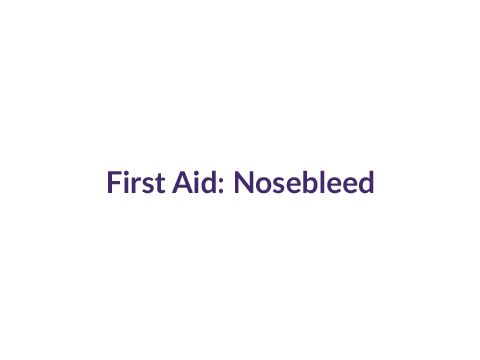Nosebleed, First Aid
Nosebleeds are commonly caused by certain medical conditions (eg, colds, allergies, high blood pressure, and bleeding abnormalities such as hemophilia or von Willebrand disease), extreme cold and/or dry air, nose picking, strenuous activity, certain medications (eg, those for colds and allergies), and being hit in the nose. Nosebleeds can also occur spontaneously.
Most nosebleeds occur in the front of the nose when there is damage to the blood vessels. Sometimes, nosebleeds occur in the back of the nose, causing bleeding into the throat.
Most nosebleeds are not a medical emergency and can be treated with basic first aid measures.
Who's At Risk?
People who live in cold, dry climates or at high altitudes; people who often have colds and/or use nasal sprays; people with certain medical conditions, such as bleeding abnormalities; and people who disturb the blood vessels in the nose by picking are prone to nosebleeds. Additionally, people who participate in strenuous activities or exercise, such as athletes, are prone to nosebleeds.
Signs & Symptoms
Typically, nosebleeds involve blood rapidly dripping out of the nose in droplets.
A nosebleed caused by a broken nose may or may not look misshapen.
In the case of a nosebleed caused by an object lodged in the nose, the foreign object may or may not be visible.
Self-Care Guidelines
First Aid Guide
The following self-care measures for nosebleeds are recommended:
- Have the person with the nosebleed sit upright and lean forward and breathe out of their mouth, and have them try to keep calm. They should also keep their head above their heart.
- If there are any clots in the nostril, have the person gently blow them out.
- Firmly pinch the soft part of the nose, and place a cold compress on the bridge of the nose. This should be done continuously for 10-15 minutes. Do not release the pressure on the nose.
- If the person’s nose is still bleeding, repeat the above steps one more time.
Note: If the nose is still bleeding after repeating the above steps once more, seek medical care.
In the case of an object lodged in the nose, removing the object promptly is important for avoiding infection as well as for avoiding the possibility of the object moving further back into the nose. The below self-care measures should be attempted to remove the object.
- Determine which nostril is affected.
- Put gentle pressure on the opposite nostril using 1 finger.
- Have the person blow their nose.
- Encourage the person to sneeze by having them sniff pepper.
Note: Do not stick anything in the nose (eg, tweezers, pliers) to attempt to pull out the object.
In the case of a suspected broken nose, seek medical care. While awaiting medical care, the following self-care measures can be followed:
- Have the person breathe out of their mouth.
- Have the person sit upright and lean forward to prevent blood from going down the back of the throat.
- Apply a cold compress to the nose.
Note: Do not attempt to straighten a broken nose.
The following can help prevent nosebleed recurrence:
- Avoid physical activity for 12 hours after a nosebleed.
- Touch the nose as little as possible for 24 hours following a nosebleed.
- Avoid hot beverages, alcoholic beverages, smoking, and aspirin for a full week after a nosebleed.
- When lying down, elevate the head with pillows.
- Breathe from the mouth rather than the nose.
- Use a humidifier.
Treatments
The medical professional may pack the nose with gauze or an inflatable latex balloon to properly put pressure on the blood vessels to stop the bleeding.
If you have frequent nosebleeds, your medical professional may perform cautery on the blood vessels with electric current, silver nitrate, or a laser on the inside of the nostril causing the problem.
Visit Urgency
Seek emergency medical care if a neck injury or serious head injury is suspected.
Get medical help if the person with the nosebleed has a history of bleeding or bruising easily, is on any blood-thinning medication (eg, large doses of aspirin, warfarin [Coumadin]), has high blood pressure, or if the nosebleed continues after 30 minutes of the self-care measures discussed in the First Aid Guide.
If the nosebleed is occurring in the back of the nose into the throat, bleeding will be hard to stop and the person should seek medical care.
If you suspect a nosebleed caused by a broken nose, seek medical care; a broken nose that heals improperly can cause future issues, such as those affecting breathing and appearance.
If the nosebleed is caused by an object lodged in the nose and it cannot be removed by the self-care measures discussed in the First Aid Guide, seek medical care.
Trusted Links
Last modified on August 12th, 2024 at 3:14 pm

Not sure what to look for?
Try our new Rash and Skin Condition Finder
